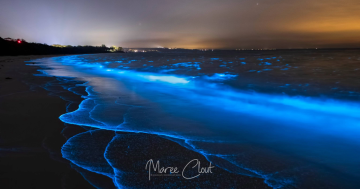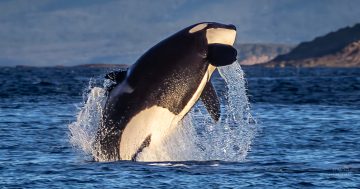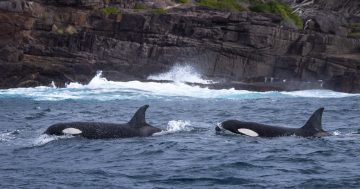
Bioluminescence in action at Nelsons, just north of Tathra. Photo: David Rogers.
The famous waters of the NSW Far South Coast have at times this week been a brilliant red by day and a luminescent blue at night.
This natural event is non-toxic and with a bit of luck will hang around for the long weekend so more people can take in the spectacle.
“Red tide is the colloquial name for the natural phenomenon of Noctiluca – a marine dinoflagellate,” explains Kerryn Wood from the Sapphire Coast Marine Discovery Centre in Eden.
“Consisting of a single species, Noctiluca scintillans is one of the most commonly occurring bioluminescent organisms in coastal regions around the world.”
Communities from Tuross to Eden have been witness to the colourful occurrence, which according to the Universtiy of Tasmania, tends to happen in the vicinity of river mouths following heavy rainfall. UTAS says the balloon-shaped cells tend to be more abundant during the warmer seasons.
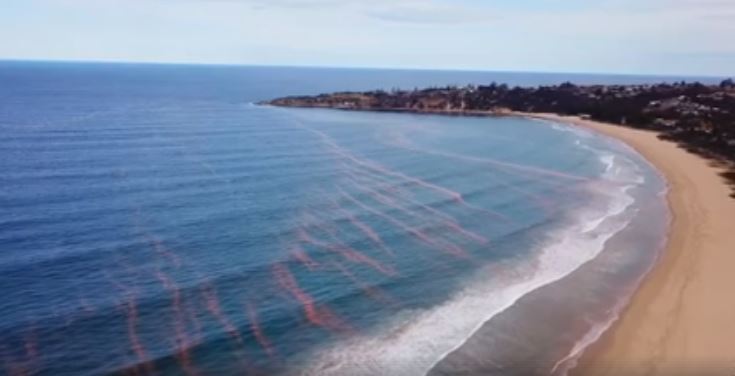
The ‘red tide’ as seen at Tathra, a natural phenomenon known as Noctiluca – a marine dinoflagellate. Photo: David Rogers.
While not considered toxic, Ms Wood, however, says the research suggests you shouldn’t come into contact with the bloom, “According to ATAS, no toxic effects are known.”
“They say don’t go swimming in it, or eat shellfish off rocks where the bloom is occurring, and that fish generally avoid bloom areas because of the presence of ammonia which irritates fish.”
While appearing as a red slick on the surface of the water by day, of a night time these organisms which on average measure about 0.5 mm turn on a brilliant electric blue show – the likes of which can only be compared to a Disney movie.
“The bioluminescence is produced by something called a luciferin reaction – which is a term for the light emitting compound found in organisms that generate bioluminescence,” Ms Wood says.
“In order for them to ‘glow’, they need to be agitated by oxygen. So, if the ocean is calm and the waves small, you are less likely to see any ‘glow’.
“If you scoop a bucket of the stuff up try putting a stick or spoon in and swirling it around, and bingo, glowy sparkly sea water!
“No reaction could also mean they have finished their life cycle and therefore will no longer emit light,” Ms Wood explains.
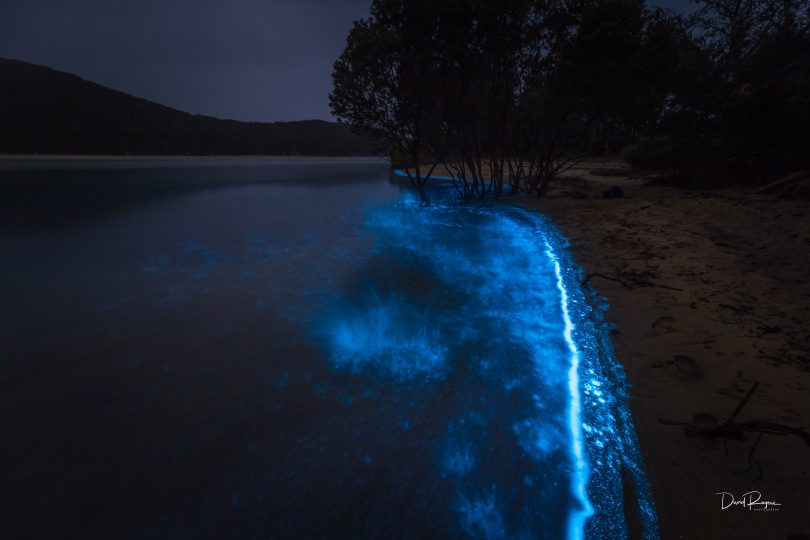
“To capture this phenomenon in a photograph you need to be prepared.” – David Rogers. Photo: David Rogers.
Photographers have relished the opportunity, photos from Tathra based pro David Rogers have gone far and wide on social media.
Mr Rogers who has worked for Fairfax, Bauer Media and News Corp, says, “The lifespan of the algae is only 48 hours – leaving only a brief window to witness this rare event, so you need to stay alert.”
“The Facebook page ‘Bioluminescence Australia’ is an excellent community page where members post sightings of the algae around Australia. This group was the first to announce a sighting in the Eden area.
“To capture this phenomenon in a photograph you need to be prepared, and forget your iphone camera, you are going to need some good camera gear.”
A few photography tips from David Rogers:
- Take a walk up your local beach during the day and try locating clumps along the shoreline;
- Get yourself ready at sunset to photograph the bioluminescence. As soon as the sun goes down the magic happens. Be prepared for a long night;
- The algae only illuminate when disturbed so you need to find a location with crashing waves on a beach or in a gentle bay with small lapping waves to capture a distinct glow along the shoreline. I was extremely fortunate to photograph it on a raining night – which caused the algae to illuminate with each raindrop;
- You will need a decent camera with manual settings, a tripod and a remote shutter control to shoot ‘long exposure photography’. This is a technique used to capture scenes in low light conditions whereby you keep the camera perfectly still and leave the shutter open for long periods. In my case I was leaving the shutter open anywhere from 30 to 90 seconds;
- Shoot for as long as possible in any condition. Yes, it was late and the conditions were miserable however this is often the time when you get the best shots. You want to get as many shots as possible as you never know when or where this rare occurrence will happen again.
“I was actually alerted to this spectacular event from a landscape photographer friend, Luke Tscharke, who is based in Tasmania and is a master at low light and astrophotography. He knew I was in the area and alerted me to be camera ready. Thanks Luke – I owe you one,” Mr Rogers says.
“And stay in contact with your local photography community to share information, techniques and results.
“It’s surprising what you can learn from being around other photographers. The ‘Sapphire Snappers’ is a friendly local photography enthusiasts group based on the Sapphire Coast who regularly meet up to shoot together while sharing photography knowledge and skills.”
Go to Facebook or Instagram to connect with Sapphire Snappers.
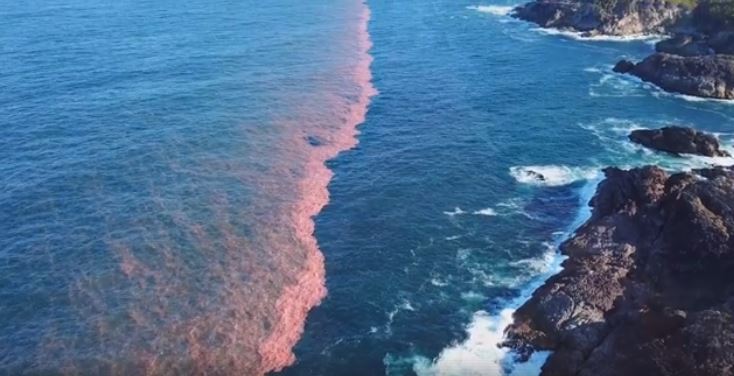
The ‘red tide’ has been spotted from Tuross to Eden this week. Photo: David Rogers.
As the working week fades, fingers are crossed that the bioluminescence seen during the week will show itself over the long weekend.
Kerryn Wood says, “They will probably eventually starve and die, or due to weather conditions sink to the bottom and lay dormant until just the right sorts of weather conditions appear again.”
“While the red sheen on the water by day can be off-putting and cause initial concern, the effect at night of these beautiful dinoflagellates are just beautiful,” she says.
“I love seeing them. Walking along the beach at night and watching waves crash is pretty awesome.
“I’ll never forget one night, diving into the waters at Bar Beach and opening my eyes, I felt like Tinkerbell – everywhere around me turned into tiny flowing ‘sparkles’ of light.”
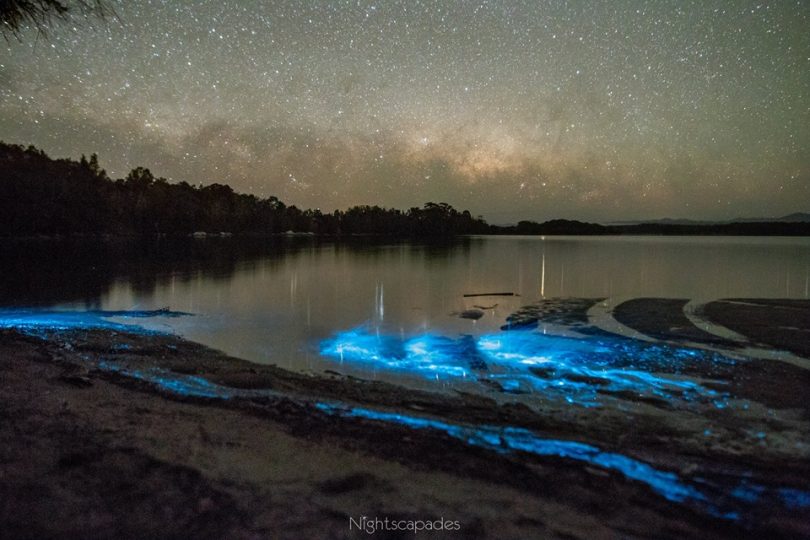
Bioluminescence captured at Tuross Head this week by Doug Ingram of Nightscapades Facebook. Photo: Doug Ingram.
The Sapphire Coast Marine Discovery Centre is open Monday to Saturday during the school holidays from 10 am to 4 pm at Snug Cove, Eden. Entry is $5 to $10 for a single, $20 for a family.
Original Article published by Ian Campbell on About Regional.












